Travel Guide, Ha Giang Loop
Ha Giang Loop Solo Traveler’s Guide to Vietnam’s Hidden Gem
The Ha Giang Loop, a 320-kilometer motorcycle ride that begins and ends in Ha Giang, is without a doubt the main attraction of Vietnam’s most northern province. Nothing compares to riding a motorcycle through mountainous terrain, crossing passes, valleys, rice fields, and minority villages. Most visitors will want to pause every five minutes to take in the scenery because of the landscape.
Ha Giang town has the best tourist infrastructure in the province, making it the ideal starting and finishing point for the loop, even though the northern provinces are still off the beaten path. Buses from Hanoi and Lao Cai (near Sapa) both go to Ha Giang; however, I strongly advise avoiding night buses when traveling north.
Ha Giang, known as the ‘Frontier Land of the Motherland, Vietnam,’ has long been renowned for its majestic natural landscapes, picturesque terraced fields, and enchanting fields of Buckwheat flowers. If you are considering a visit to this northernmost region of Vietnam, do not miss out on the following Ha Giang Loop solo travel experiences.
Best time to do Ha Giang Loop?
Ha Giang, a high mountainous province, experiences a distinctly colder climate compared to the adjacent lowland and midland regions. The average annual temperature hovers around 21-23 degrees Celsius. A notable characteristic of the climate is the high humidity throughout the year, with abundant and prolonged rainfall.
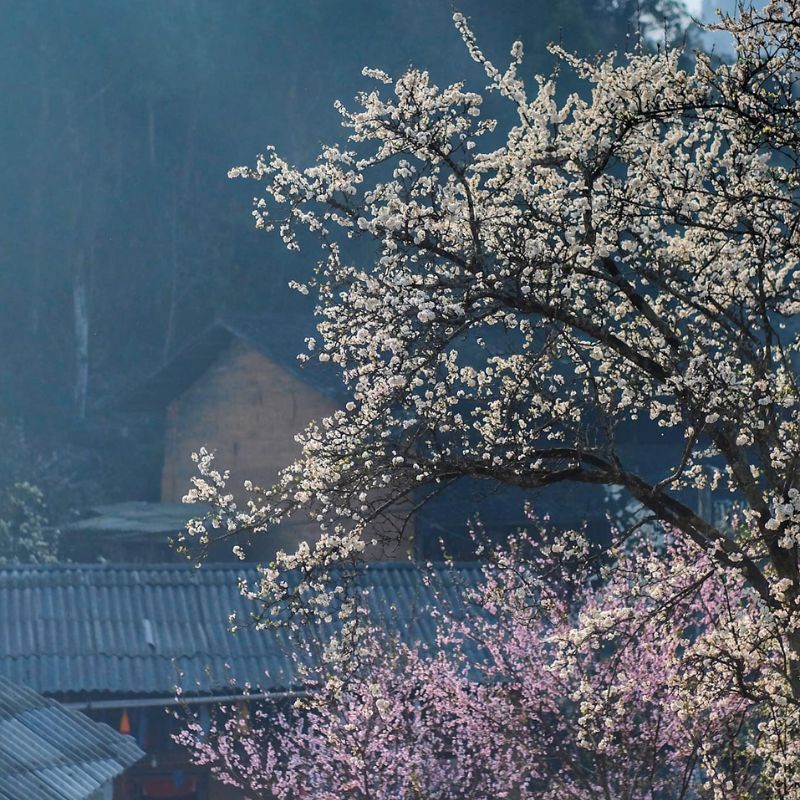
You can travel to Ha Giang in any season. People often visit during the autumn when the rice fields turn a golden yellow. The most beautiful time is October, November, and December when the buckwheat flowers or mustard fields are in full bloom. In spring, the white blossoms of peach and plum trees create an ethereal atmosphere, as if floating amidst the clouds.
In May, the shimmering water-filled rice terraces begin to emerge. In June and July, Ha Giang is less frequented due to sudden summer rains. However, these rains bestow the mountains and forests with a captivating lush greenery.
How to get to Ha Giang
Vietnam’s far north is home to Ha Giang. From Hanoi and Sapa, two other well-known tourist destinations in North Vietnam, you can get there in a single day.
From Hanoi
Travelers can choose between sleeper buses or high-quality limousines, depending on their budget. However, taking a night bus is advisable to save time and conserve energy for the long exploration ahead. Bus fares from Hanoi to Ha Giang vary between 200,000 – 300,000 VND one way.
From Sapa
From Sapa, a minibus departs daily for Ha Giang. Given the state of the roads, it’s not the most comfortable bus and isn’t a sleeper either. However, it’s tolerable. It takes six to seven hours and costs 300,000 VND, or $12.7.
Once more, you can simply make that reservation through your Sapa hostel.
Upon reaching Ha Giang city, you can rent a motorbike for self-guided tours at a daily rate of 150,000 – 300,000 VND. Alternatively, for those short on time or energy, or traveling with elderly and children, renting a 7-16 seater car is recommended.
Beautiful Hotels and Homestays
For families or couples seeking a luxurious, private retreat, P’apiu in Yên Định, Bắc Mê is an excellent choice. Here, visitors can immerse themselves in the highland’s vibrant colors, staying in villas designed in the traditional H’Mong style. A night’s stay costs around 10,000,000 VND.
For those seeking something unique, H’Mong Village with its quẩy tấu design is a suggestion. This resort is located on the hills of Trang Kim, Quan Ba, overlooking the Mien River and distant majestic mountains. Accommodation options include community rooms at 400,000 VND per night or quẩy tấu bungalows at 2,400,000 VND per night.
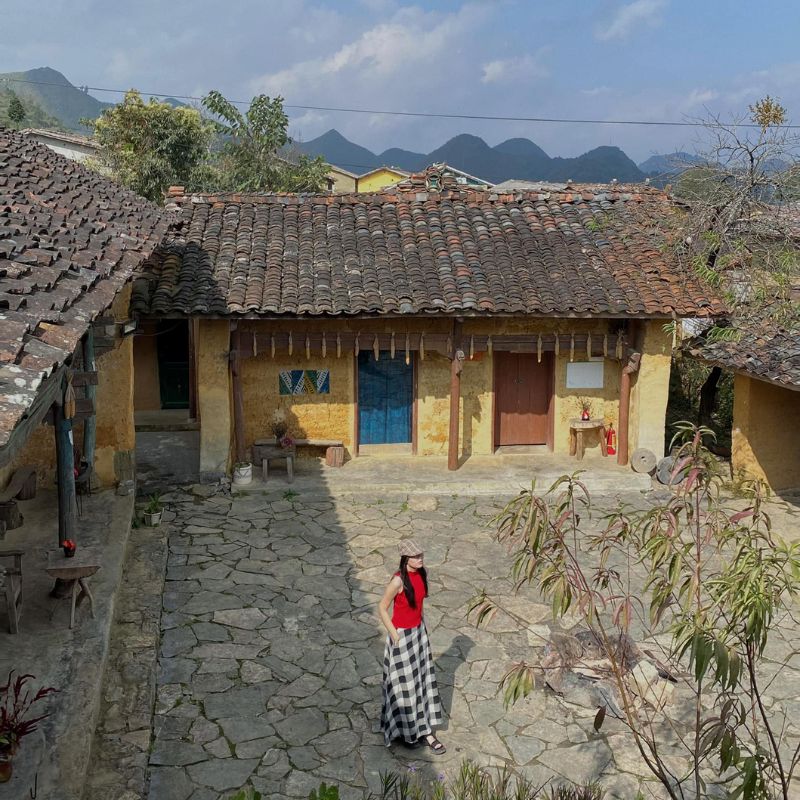
For a more community-centric and affordable option, various homestays are available. In Hoang Su Phi, there’s Hoang Su Phi Lodge and Kinh Homestay near the terraced fields of Nam Hong village; Ho Thau Eco Village in Ho Thau commune offers traditional stilt houses.
Additionally, Chung Pua – Auberge de MeoVac in Meo Vac with its local-style earthen houses and Bụi Homestay in Dong Van offer authentic experiences. In Dong Van, there’s also the ancient Hoàng Thân house at 100,000 VND per person and Ong Vàng Meo Vac at only 230,000 VND per night. Near the Lũng Cú flagpole, the Lo Lo Ancient House Homestay is available.
Suggested 3-day 2-night Ha Giang Loop itinerary
Since tourist spots in Ha Giang are spread out, a minimum of a 3-day and 2-night trip is recommended to adequately explore. Many suggest a 3-day 4-night itinerary, or, for a more relaxed pace, 5 days.
Here’s a suggested itinerary for a 3-day 2-night trip.
Day 1: Hanoi – Ha Giang – Dong Van
To reach the Dong Van Sunday market in time, depart from Hanoi on Friday night. Start your journey to Dong Van the next morning at 8 am, enjoying the morning air and taking photos along the way. Divide the route from Ha Giang city to Dong Van into segments for a more enjoyable trip.
Segment 1: Ha Giang – Quan Ba Heaven’s Gate (40 km)
From the city, the first stop is the Km 0 landmark, then on to Quan Ba, about 40 km away. Heaven’s Gate is a famous check-in point, but if you travel in winter, you might encounter fog. On clear days, you can take photos and enjoy the view of the fields below.
From here, you can see Nam Dam Lake in Nam Dam village, a famous homestay village of the Dao people in Quan Ba. Besides Heaven’s Gate, you can also visit the nearby Fairy Mountains.
Segment 2: Quan Ba Heaven’s Gate – Yen Minh town (30 km)
Note that there are two paths at the Can Ty bridge; the uphill path saves you 20 km but is more challenging and requires experienced drivers. Plan to reach Yen Minh for lunch.
Segment 3: Yen Minh town – Dong Van old town (45 km)
This route offers many beautiful landscapes and tourist spots. Notable are the Tham Ma slope and the 9-turn pass, iconic check-in points in Ha Giang. Here, you’ll likely meet international travelers, landscape photographers, and local Mong children carrying flower baskets.
Day 2: Dong Van – Meo Vac
Spend some morning time at the bustling Dong Van market, a unique cultural feature not found in the lowlands. The market offers a wide range of products, from common items like electronics, fruits, clothes to ethnic specialties like linen fabric, embroidery, buckwheat cakes, and thắng cố. For souvenirs, choose easily transportable items like spices or linen fabric.
At around 9:30 AM, you’ll head back the same way towards Dong Van, then follow the route to Meo Vac and reach Nho Que River. The motorbike path leading down to the boat dock is steep and in some places under construction, requiring skilled riders. If you’re not confident, you can hire a local motorbike taxi service for 150,000 VND for a round trip.
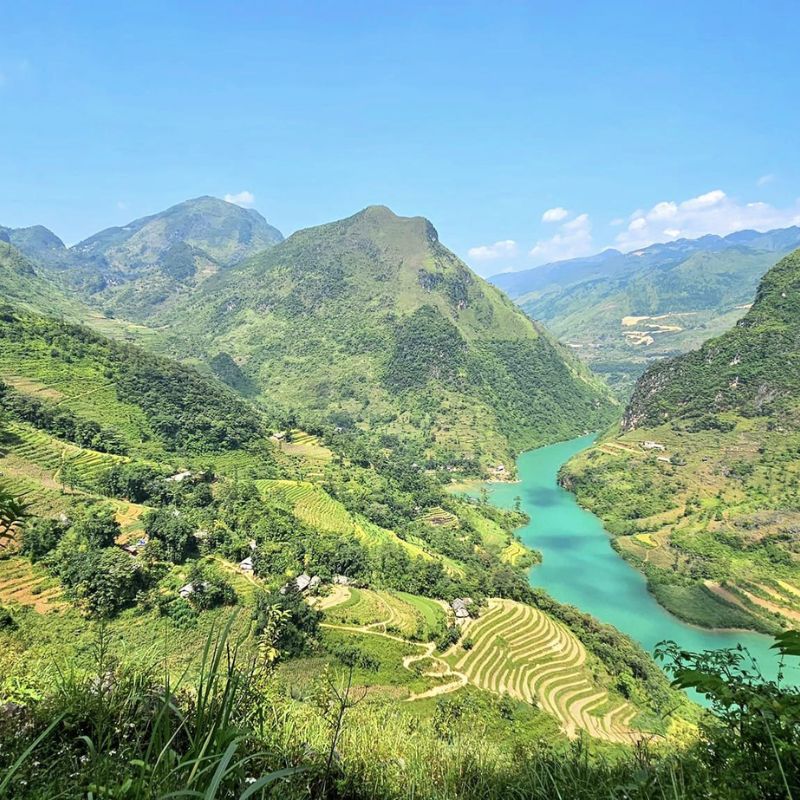
The challenging road, with its rough patches, is compensated by the stunning beauty of the emerald Nho Que River, easing the fatigue of travelers. Winding along the path hugging the mountain, you’ll arrive at the boat dock. A boat trip on the Nho Que River costs 100,000 VND per person and lasts about 40 minutes, usually stopping at Tu Sản Alley for the most picturesque photo opportunities.
Around 2:30 PM, head towards Meo Vac to visit Mã Pì Lèng Pass. The winding road is broad and flat, flanked by mountains on one side and a deep valley on the other.
Surrounded by sky, clouds, and mountains, travelers can leisurely enjoy the scenery and take photos. At the base of the pass, visit the Happy Road Museum to learn about the challenging history of the construction of National Route 4C, connecting Ha Giang City, Dong Van, and Meo Vac.
The journey from Ma Pi Leng Pass down to Ta Lang village, Pai Lung commune, Meo Vac district is unforgettable. The 8 km road features over 50 sharp turns and steep inclines.
Around 5 PM, you can stop at the 12 km mark to Meo Vac. This spot offers a beautiful sunset view over Ma Pi Leng Pass, with the Nho Que River in the foreground. After sunset, it’s a 10 km journey to the Mông ethnic culture village in Pa Vi for an overnight stay.
Day 3: Meo Vac – Ha Giang City – Hanoi
In Pả Vi, the peaceful scenery of endless mountains greets waking visitors. Meo Vac is about 150 km from Ha Giang, so start early to catch the bus back to Hanoi. There are two bus schedules: one at 2 PM (arriving in Hanoi at 9 PM) and another at 9 PM (arriving in Hanoi at 4 AM the next morning).
If choosing the 2 PM schedule, depart at 8 AM from Meo Vac and head straight via Mau Due – Yên Minh – Quan Ba – Ha Giang city, without stopping for sightseeing. Be aware that the road from Meo Vac to Mậu Duệ can be rough, with many potholes.
For the 9 PM bus from Ha Giang City, you’ll have time for additional sightseeing. Take the route via Mau Due – Đường Thượng, visit Lùng Tám weaving village, pass through Quản Bạ, and explore Lùng Khúy cave before heading to Ha Giang city.
Note: I firmly advise you to give an Easy Rider serious thought if you’re a novice driver. You shouldn’t do the Loop on your own just because some careless people do.
Riding on the back of a motorcycle driven by a skilled operator is commonly referred to as being an “easy rider.” The Ha Giang Loop is typically performed in this manner. You have the option of taking a tour or hiring a private driver. Hiring a private motorbike driver on the loop can cost up to 800.000 VND (about $34) per day, plus you’ll also need to cover their lodging and meals.
What to eat in Ha Giang
In Ha Giang, don’t miss the egg-filled bánh cuốn, with its thin, moist layer of dough and a heart of vibrant red egg yolk, a specialty of this northernmost region.
Another must-try is the ấu tẩu porridge, made with yellow sticky rice mixed with ordinary rice, and ấu root simmered in rich pork broth with various herbs. This porridge is not just a meal but also a medicinal remedy.
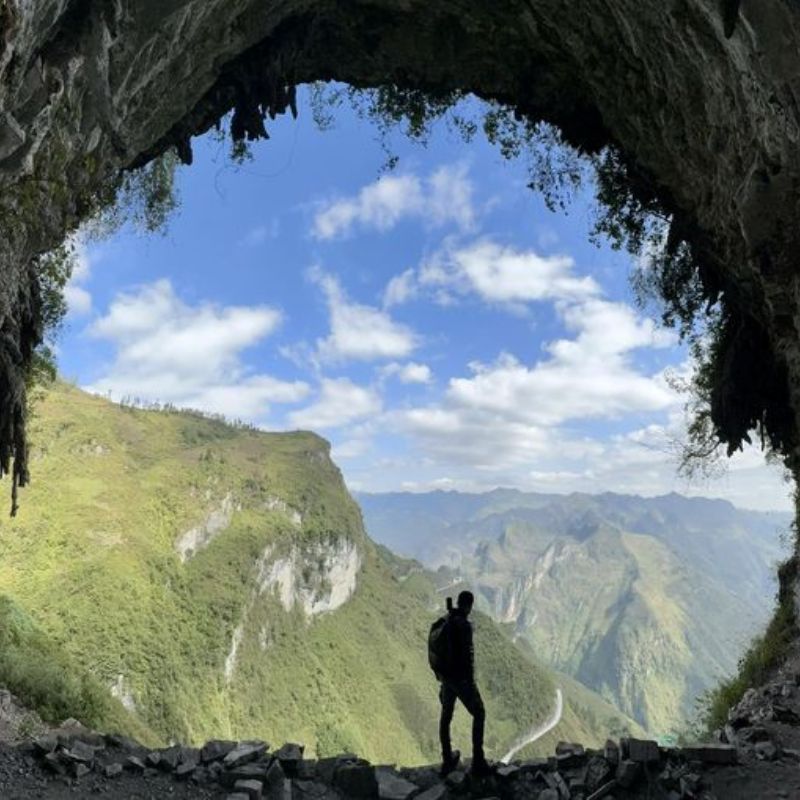
Ha Giang’s bánh chưng gù, hand-wrapped with either green or black rice (depending on the type of rice used), contains both lean meat and fat. This local delicacy, made daily by a few families in Ha Giang city, requires advance orders due to limited availability. Each cake costs from 17,000 VND.
Thắng dền in Dong Van resembles Hanoi’s bánh trôi tàu, made from glutinous rice flour, available in vegetarian or filled versions.
Thắng cố, a Northwest specialty with a rich aroma of spices and succulent meat, may not suit everyone’s palate.
The ấu tẩu porridge, cooked with mountain rice, pork legs, and ấu root, offers a unique bitter taste. The root is potent and must be carefully prepared, serving as a hangover cure and joint pain reliever. This porridge is typically sold only in the evenings.
Bánh tam giác mạch, a distinctive cake of the H’Mong people in the rocky highlands, involves a meticulous process of drying and grinding buckwheat, mixing with water, and then steaming in round, flat shapes. The cakes are then grilled or fried, offering a slightly gritty, sweet flavor.
Cơm Lam Bắc Mê, a bamboo-tube rice of the Tày ethnic group, is aromatic, combining the scents of banana leaves and bamboo tube. It pairs well with sesame salt or grilled stream fish.
Which bike to choose for the Ha Giang loop?
Selecting a bike is one of the most crucial decisions you will make on your Ha Giang Loop solo.
Ha Giang’s roads are generally in good condition, in contrast to a decade or so ago when it was not such a well-liked tourist destination.
However, you should be aware that landslides frequently occur and that the roads cross over large mountains. As a result, certain roads may become momentarily blocked and unusable.
Dirt bike – Skilled riders
Our decision to go with the Honda XR 150cc proved to be excellent because it was incredibly comfortable for both of us, even with a large bag strapped behind.
These bikes are excellent on smooth, uneven, and slightly off-road routes. This allowed us to select a slightly different path at certain points along the loop.
Semi-automatic – Recommended
For everyone, semi-automatic bikes are the ideal choice for completing the Ha Giang Loop.
It shifts gears automatically to make descending hills easier, but it also maintains its gear when you stop. When you have to stop in the middle of a hill, this is really helpful.
You won’t need to use the brake as often when riding a semi-automatic bike as you would a fully automatic one. This helps prevent you from slipping and overbraking in wet conditions.
Ha Giang Loop Solo travel tips
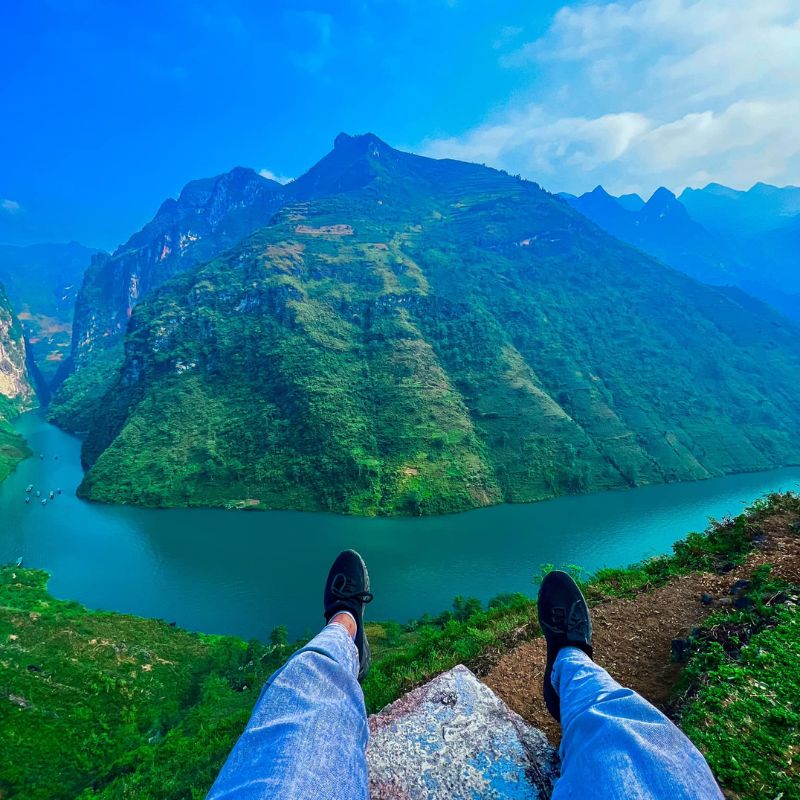
- Take a four- or five-day trip to complete the loop if you have the time. In this manner, you can ride a motorcycle around the loop at your own pace and take in the breathtaking scenery the region has to offer.
- Even though the distances don’t seem very far, try to avoid leaving too late because then some of the sections feel hurried.
- The road is generally in good condition, but there are some areas with large potholes that could damage your tire or cause you to fall. Pay attention to the road.
- Flashpackers and hikers will find a range of lodging options in Yen Minh, Dong Van, and Meo Vac.
- It’s easy to find eateries that serve Pho and meat-based rice dishes, though locals often take a break after noon when businesses close.
- Lastly, please take your time. There were parts of the trip that, in my opinion, required some time to fully appreciate – you had to sit down and take it all in. Therefore, try not to hurry the trip.
The freedom and flexibility of solo travel on the Ha Giang Loop allow for a deeply personal and enriching experience. Whether it’s interacting with local communities, savoring the regional cuisine, or simply soaking in the serene beauty of northern Vietnam, the journey promises a tapestry of memorable moments. Yet, it’s crucial to acknowledge the challenges, including navigating language barriers, dealing with remote and rugged terrains, and ensuring personal safety
In conclusion, the Ha Giang Loop solo journey is an invitation to adventurous spirits seeking to explore beyond the beaten path. It’s a testament to the beauty of Vietnam’s landscapes and the resilience of its travelers. With the right preparation, respect for local culture, and a spirit of adventure, this journey stands as an unforgettable chapter in the travel diaries of those who dare to explore it solo.
FAQs
Can you do the Ha Giang Loop by car?
Taking a driver-led tour of Ha Giang’s captivating landscape is the most secure and comfortable way to see it. Although it’s not the “classical” method, it’s something we would absolutely suggest to families or people who are just uncomfortable riding a motorcycle on their own or as a passenger. Also, if you’re traveling with kids, renting a private vehicle is the ideal way to complete the Ha Giang Loop.
Is It Safe to Drive Solo?
Driving solo on the Ha Giang Loop depends on your motorbike experience and preparation. Road conditions can be unpredictable with potential hazards. It’s important to drive defensively, be aware of surroundings, and check road and weather conditions.
What Should I Pack?
Essential items include warm clothes, rain gear, sunscreen, insect repellent, a first-aid kit, and sufficient cash since ATMs are rare in remote areas. Also, carry a map, phone, and power bank. Adjust your packing list based on the season and expected weather conditions.
What Are Alternatives to Solo Travel?
If solo travel seems daunting, consider joining a guided tour, renting a motorbike with a guide, or using public transportation. Each option offers different levels of flexibility, local insight, and convenience.
Is the Ha Giang Loop Dangerous?
The loop can be dangerous, especially for inexperienced riders. The roads are narrow and winding with steep drops and sharp turns. Rapidly changing weather conditions can also add to the challenge. However, with the right precautions, risks can be minimized.
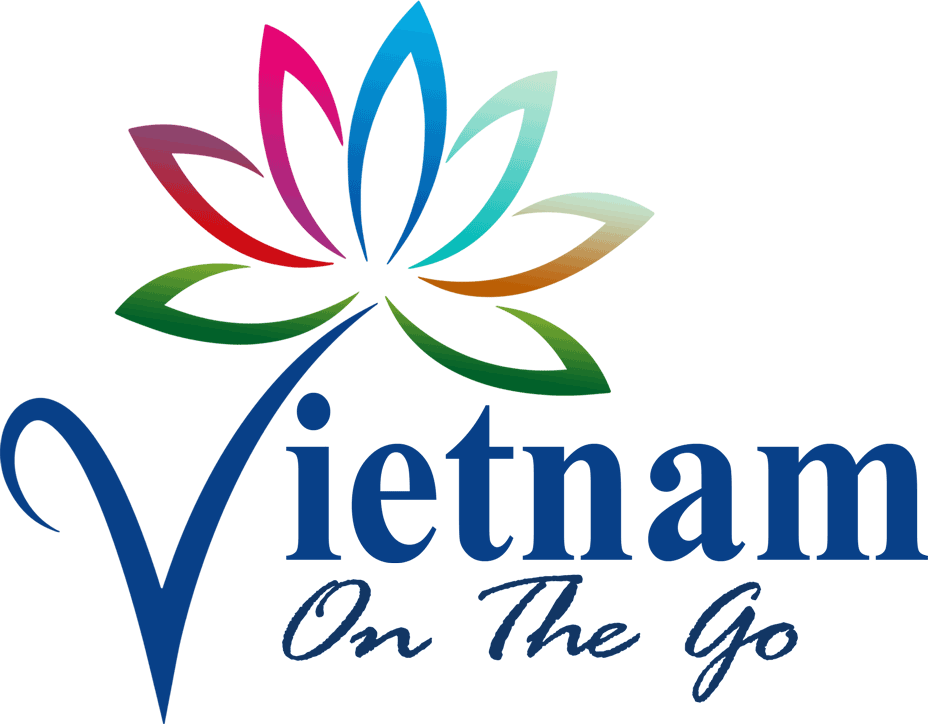

![[3 DAYS 4 NIGHTS] Ha Giang Loop Motorbike Tour from Hanoi](https://vietnamonthego.com/wp-content/uploads/2024/03/ha-giang-loop-tour-6-300x300.jpg)
![[4 DAYS 5 NIGHTS] Ha Giang Loop Motorbike Tour from Hanoi](https://vietnamonthego.com/wp-content/uploads/2024/03/ha-giang-loop-tour-300x300.jpg)